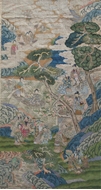![]() The Jodhpur Auction
The Jodhpur Auction
![]() The Jodhpur Auction
CLASSICAL CHINESE PAINTING
The Jodhpur Auction
CLASSICAL CHINESE PAINTING
RELATED LOTS
CONTACT US
Catalogue & Viewing
Lot Closed
Accounts & Shipping
Lot Closed
-
Literature
 Literature
Literature

The Chinese love fruits as temple offerings but they also love them for their suggestiveness and symbolic content. Various fruits play critical roles in Chinese everyday life in their shape, flavours and colours and are used as significant symbols, whether as harbingers of wishes for good luck, fertility or longevity.
This classical Chinese narrative painting, probably from the 16th century, is extraordinary and unique on many levels. Painted within a Chinese solitary alphabet, it embraces a lengthy narrative of life within a wealthy sovereignty. The king, in his imperative omnipotent position, holds a ripening fruit, perhaps a loquat, or Chinese pipa, in his hands. Smiling benignly, he holds the fruit preciously. In attendance on his right side is a musician whose music has even enthralled a deer, while on his left is the stork, the patriarch of feathered birds and a symbol of longevity. Storks also represent officials in the king’s court. Here the stork is accompanied by officials offering the same fruit to the king. On the next level is the queen in her royal position and splendour. At her sides are the ubiquitous monkeys, as ready entertainers, and also bearing the fruits of longevity. Below her is a hierarchy of subjects engaged in daily activities. As the alphabet progresses, on tiered levels life goes on with subjects conducting their everyday lives in close concert. Dressed in bright flowing hanfu, large in their presence, they engage and interact, playing their roles diligently. The groups of folks are linked by extraordinary patterning. Encompassed within the strokes of the alphabet, this painting is testimony to the Chinese indeed being masters of calligraphy - the art of beautiful writing and to this day learning to write the picturesque Chinese alphabet with a brush continues to be an important part of their education.

